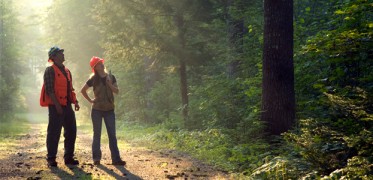Predicting the Future of Maine’s Forests

Understanding how forests function as complex adaptive systems and predicting the future characteristics of Maine’s woods are goals of a project by a team of University of Maine researchers.
The study also aims to improve an open-source forest ecosystem model to help make project insights more transferable to research in other forests.
Erin Simons-Legaard, a post-doctoral research scientist in the UMaine School of Forest Resources, is principal investigator of the project titled “When natural disturbance meets land-use change: An analysis of disturbance interactions and ecosystem resilience in the Northern Forest of New England.”
“We can’t control everything, but it’s important to understand the processes that are controlling what type of forest grows after it’s cut down and identify the underlying interactions between the human decision-making process and ecological dynamics,” Simons-Legaard says. “Once we identify where the interactions are the strongest, we know what pathways we can use if we want to change what our future forests will look like.”
Working with Simons-Legaard on the project are Jessica Leahy, an associate professor of human dimensions of natural resources at UMaine; Kasey Legaard, an associate scientist in the School of Forest Resources; Aaron Weiskittel, an associate professor of forest biometrics and modeling and Irving Chair of Forest Ecosystem Management at UMaine; and Emily Silver, a Ph.D. student in the School of Forest Resources.
The two-year project, which began in July 2013, was awarded a $235,494 National Science Foundation grant.
The relationship between the biophysical and social subsystems is an important factor in understanding how forest ecosystems work as complex systems.
“No two acres of forest are exactly the same unless you plant it — if even then — and that’s because forests are complex,” Simons-Legaard says.
The researchers are creating future projections of the northern half of Maine — about 10 millions acres — by focusing on the interactions between man-made disturbances such as harvesting and development, and natural disturbances such as wind and pests.
Periodically Maine’s northern forests will have an infestation of the eastern spruce budworm — a pest that targets balsam fir and spruce trees, two common and economically important tree species in Maine. During the last outbreak, a lot of spruce-fir forest became infested and was then salvaged. In many areas, fir and spruce were replaced by shade-intolerant northern hardwoods that can establish and grow faster than the softwood trees in open areas. This replacement can occur when spruce-fir forest is harvested before the understory completely develops.
“Researchers are trying to understand what drives that shift from softwood to hardwood and what it might mean for natural resources like wood supply and wildlife habitat,” Simons-Legaard says. “Maine’s northern forest has traditionally been spruce-fir dominated, and a big shift toward hardwood in a historical context would be unprecedented.”
For several years, Simons-Legaard and her husband Kasey Legaard had focused on the state’s two main disturbance agents — harvesting and spruce budworm. Since their research began, the pair noticed more discussion about development and what role it could potentially play in northern Maine.
The researchers decided to include land-use change as a disturbance to take a more comprehensive approach to understanding how forests work.
“Taking this approach means recognizing you have the natural system with its components — trees, soil communities of microbes and bacteria, wildlife community — and they are all interacting. Then you have people interacting in their social system and making decisions. In a forest, the natural system and the human system interact,” Simons-Legaard says.
Learning more about these interactions and how they might be influenced by different disturbances is at the core of the team’s research.
“For the social side the focus is on what influences a landowner’s decision to stop producing timber and develop. That’s what Jessica Leahy and graduate student researcher Emily Silver are focused on; the decision-making process of the landowners,” she says.
To make their results more transferable to other timber-producing forests, the team used an already-established software program instead of creating a project-specific program. The group is using LANDIS-II, a cell-based forest ecosystem model which has an active community of users and developers. Any improvements the researchers make to the software can quickly be distributed to all of its users.
Using a map of initial forest conditions and text files describing the life history characteristics of the area’s tree species, the program creates future projections of the forest by growing trees, dispersing seed, establishing new cohorts of trees and accounting for natural mortality. The program also has extensions that allow the researchers to add disturbances, such as harvesting.
For two years the team has been preparing the input files. The map of the area’s initial conditions of tree species and forest age was created using satellite imagery and U.S. Forest Service’s Forest Inventory and Analysis (FIA) plot data.
Text files created for the 13 most abundant tree species in Maine describe how species’ growth and mortality is influenced by environmental conditions. The files help the program model species establishment and competition after a disturbance.
“These text files have to describe in numerical terms what tree-species competition looks like and how species rank in terms of competitive ability,” Simons-Legaard says.
Once the files are complete, the information is entered into LANDIS-II, along with the disturbance extensions, to determine what Maine’s forests will look like in the future.
“There’s also a regional focus because we’re trying to understand Maine’s forests better; both the natural components, how they interact, how tree-species competition determines whether a forest comes out as softwood or hardwood, and how Maine’s landowners make their decisions,” Simons-Legaard says.
As spruce budworm begins to make its return and land-use change becomes more frequent, asking the preemptive “what if?” questions are important in determining where Maine’s forests are headed in the next 50 or 100 years, she says.
Contact: Elyse Kahl, 207.581.3747
